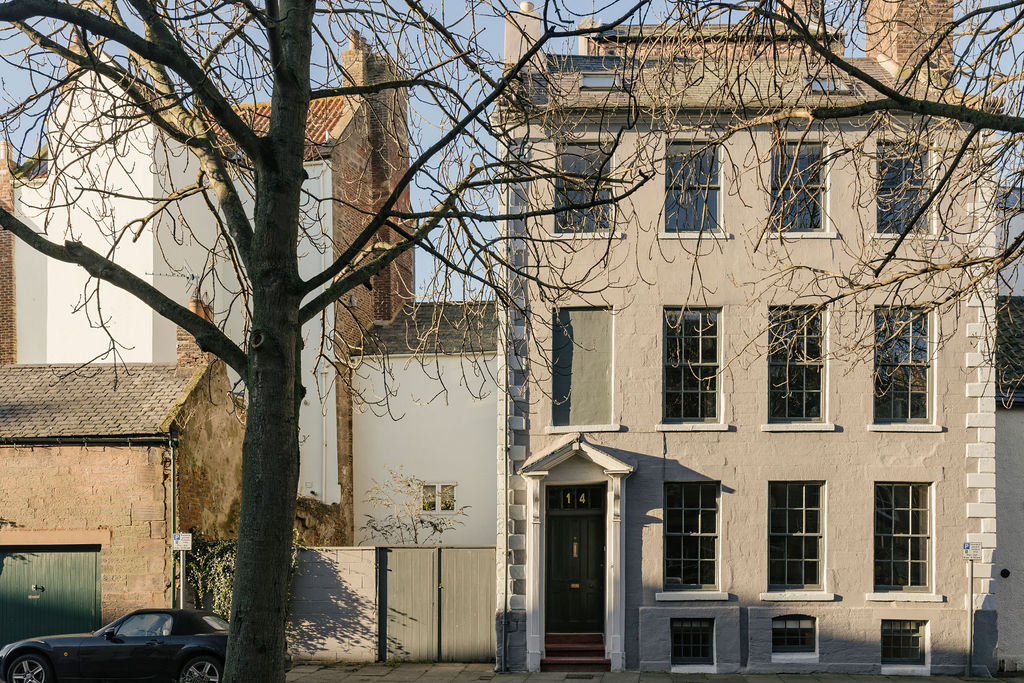Within, beautiful joinery can be found in abundance; the cupboards and much of the architectural hardware is original. The impressive hall has large flagstones underfoot, wonderfully patinated from the thousands of footsteps it has received since its original purpose as an external passage through to the city wall.
For more information on the surrounding area, please see the Historysection below.The Grand Tour
Entry is through a classical timber portico and opens to a voluminous hall, with access to the garden to the left. To the right, a door leads to a centrally located staircase providing access to all floors. Original floorboards run underfoot throughout.
At the front of the plan is the living room, beautifully appointed and featuring original panelling, cornicing and cupboards. There is a neutral and contemporary flavour to this space, yet a simultaneous sense of respect for the home’s original fabric.
On the lower ground floor is a spacious kitchen, as well as several former vaults that are currently used as utility spaces. A single span of simple cabinetry runs along one wall of the kitchen, with a large gas range set into the chimney recess. The dimensions of the space allow for dining for up to 10 people with ease and clerestory glazing provides ample light.
A large room on the first floor runs the width of the building. Likely to have been the drawing room in days past, this now forms the pinnacle of Tod’s installation. However, it could easily be returned to its original use as a drawing room; it would work equally well as a main bedroom. The space retains its original fabric, including an elegant 18th-century fireplace with a cast iron, Victorian insert. A south-facing oculus window allows a dramatic shaft of light into the room, which moves with the seasons. A bathroom lies to the rear.
Ascending another level leads to two generously proportioned bedrooms. One of these contains another of Tod’s brilliant installations, focusing on a frame-grid motif that directly interacts with the structure of the room. Another 18th-century fireplace, also with a Victorian insert features; as with the other installation, the works undertaken do not impinge on the building’s original fabric. A second bathroom lies to the rear, mirroring the plan of the floor below.
The attic has an altogether different character, with lower ceilings and humbler decorative elements. Two bedrooms can be found on this floor, both of which are serene and cocooning spaces.
The Great Outdoors
A private courtyard garden lies to the side of the house. South- and east-facing, this is home to a deep mature bed populated with shrubs and small trees. The ancient wall of the neighbouring home surrounds the space, making it feel truly ‘of’ the town.
For adventures in nature further afield, there are numerous walks along the River Tweed and beyond. Wonderful local beaches include Fisherman’s Haven Beach, Cocklawburn Beach, and the beachfront and lighthouse at Berwick-upon-Tweed itself. A five-minute walk onto the ramparts leads to walks around the historic town walls and to walks that extend for miles, with gorgeous views of the bridges, river and surrounding landscape. The
Lowry Trail, named after the famed painter, takes in many of the favoured local sights.
Out and About
Palace Street and the surrounding roads form a small, close-knit community at the centre of Berwick’s historical civic society. The house is a short walk from both the
Berwick Museum and Art Gallery and Nicholas Hawksmoor’s
Barracks and Main Guard, Britain’s earliest barracks building.
There are excellent amenities within Berwick itself, just a five-minute walk from Palace Steet, including a great selection of independent bakers, butchers and fishmongers. Eateries include The Mule on Rouge and The Barrels Alehouse pub, alongside microbrewery The Curfew and coffee roasters Northern Edge.
Audela restaurant,
Atelier wine bar and Indian restaurant
Amran’s are also of particular note. There are brilliant independent bookstores and antique shops along Bridge Street. Live music events take place at The Barrels and
Radio Rooms, while the
Maltings theatre and arts institution acts as a cultural centre. Throughout the year there are food festivals, historic festivals and literary festivals, including the
Berwick film and media festival every August. Important local landmarks and day-out destinations include Holy Island,
Lindisfarne Castle and
Bamburgh Castle, plus stately homes such as
Paxton House,
Mandeston House and
Chillingham Castle, St Abbs and Coldingham
There is a good selection of state primary, middle and senior schools in Berwick, including Berwick Academy; Longridge Towers is an excellent co-ed independent school for all ages a couple of miles outside neighbouring Norham.
Berwick-upon-Tweed is only 45 minutes by train to the centre of both Edinburgh and Newcastle upon Tyne, while London King’s Cross can be reached in around three and half hours. The train station is a less-than 15-minute walk from Palace Street. The A1 is a short drive away and acts as the main road link to Newcastle and Edinburgh. Additionally, both Edinburgh and Newcastle International airports offer routes to most European cities and holiday destinations, as well as London Heathrow and other southern English airports.
